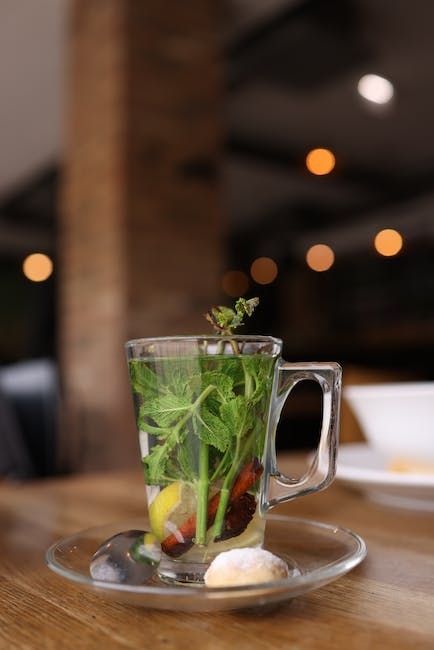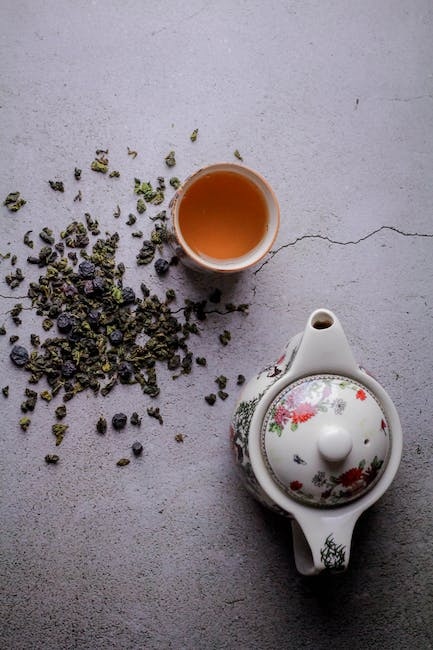Discovering the Fascinating History of Oolong Tea
Tea lovers around the world know that oolong tea is a unique and complex beverage that offers a rich flavor and aroma. But did you know that this delightful tea has a fascinating history that stretches back centuries? Let’s explore the origins and evolution of oolong tea, from its humble beginnings in China to its current status as a beloved beverage enjoyed by millions.
The Birth of Oolong Tea
The story of oolong tea begins during the Ming Dynasty in China, which lasted from 1368 to 1644. It is believed that oolong tea was first cultivated in Fujian province, where tea farmers would carefully process the leaves to create different types of tea.
The name “oolong” translates to “black dragon” in Chinese, which refers to the dark, twisted shape of the tea leaves. According to legend, oolong tea was discovered by accident when a tea farmer in Fujian province forgot about his tea leaves as he tended to other tasks. When he returned to the tea leaves, they had partially oxidized, resulting in a unique flavor and aroma.
Spreading Across the Globe
After its discovery, oolong tea quickly gained popularity in China and was soon exported to other countries, including Japan and Taiwan. During the 19th century, oolong tea became a favorite of the British, who enjoyed its complex flavor and aroma. It was also during this time that oolong tea production began to spread beyond China’s Fujian province to other regions, such as Taiwan.
The Many Faces of Oolong Tea
Today, oolong tea remains a popular beverage around the world, with different regions and producers offering their unique interpretations of this beloved tea. Oolong tea can vary greatly in flavor, aroma, and appearance, depending on factors such as the region it is grown in, the processing method used, and the specific cultivar of tea plant used.
Some oolong teas are lightly oxidized, resulting in a delicate, floral flavor, while others are more heavily oxidized, offering a bolder, richer taste. Oolong tea can also be blended with other ingredients, such as fruits, flowers, or herbs, to create unique and flavorful blends.
Final Thoughts
The history of oolong tea is a testament to the creativity and ingenuity of tea farmers and enthusiasts throughout the centuries. From its accidental discovery in China to its current status as a globally beloved beverage, oolong tea has come a long way. Whether you prefer a light and floral oolong or a bold and rich blend, there is no denying the allure of this unique and complex tea.
The Amazing Health Benefits of Oolong Tea
Tea lovers rejoice! Oolong tea, also known as Wu Long tea, is a delicious and nutritious beverage that offers a plethora of health benefits. This traditional Chinese tea is made from the leaves of the Camellia sinensis plant and is known for its unique combination of compounds, including caffeine, theanine, and catechins.
Weight Loss and Metabolism Boosting
One of the most well-known benefits of oolong tea is its ability to boost metabolism and promote weight loss. Research has shown that oolong tea increases fat oxidation and energy expenditure, which can lead to a reduction in body weight. Plus, the caffeine in oolong tea can help increase energy levels and improve exercise performance.
Antioxidant Properties
Oolong tea is also packed with antioxidants that help protect against oxidative stress, which can lead to chronic diseases such as heart disease, diabetes, and cancer. The catechins in oolong tea are especially potent antioxidants that have been shown to have anti-cancer properties.

Improved Mental Function
The theanine in oolong tea has been found to promote relaxation and improve mental alertness and focus. This amino acid works by increasing alpha brain waves, which are associated with a state of relaxation and mental clarity. In addition, the caffeine in oolong tea can help improve cognitive function and memory.
Bone Health
Oolong tea has also been associated with improved bone health and a reduced risk of osteoporosis. The flavonoids in oolong tea have been shown to increase bone mineral density and improve bone strength.
Blood Sugar Regulation
Some studies suggest that oolong tea may help lower blood sugar levels and reduce the risk of type 2 diabetes. The polyphenols in oolong tea have been shown to improve insulin sensitivity and reduce blood glucose levels.
Conclusion
Overall, drinking oolong tea regularly can contribute to improved wellness and a healthier lifestyle. Whether youre looking to boost your metabolism, improve your mental function, or protect against chronic diseases, oolong tea is a delicious and nutritious beverage that offers a wide range of health benefits.
Exploring the World of Oolong Teas: Types, Flavors, and Aromas
Tea lovers around the world can attest to the fact that there are few things more comforting than a warm cup of tea. Among the many varieties of tea, oolong tea stands out for its unique flavors and aromas that can vary depending on the level of oxidation during processing. In this blog post, we will delve into the world of oolong teas and explore the different types, flavors, and aromas that make them so special.
Types of Oolong Teas
Generally, oolong teas can be categorized into four types based on the level of oxidation: light, medium, dark, and heavily roasted. Let’s take a closer look at each type and the characteristics that make them unique.
| Type of Oolong Tea | Level of Oxidation | Flavor Profile | Color when Brewed |
|---|---|---|---|
| Light Oolong Tea | Least oxidized | Natural floral and fruity flavors | Pale yellow to light green |
| Examples: | Tie Guan Yin (Iron Goddess), Bai Hao (Oriental Beauty), Da Hong Pao (Big Red Robe) | ||
| Medium Oolong Tea | More oxidized than light oolongs but less than dark or heavily roasted ones | Balance of floral and fruity notes with a slight nutty or toasty flavor | Golden or amber |
| Examples: | Dong Ding (Frozen Summit), Wuyi Yan Cha (Rock Tea), Ali Shan | ||
| Dark Oolong Tea | Heavily oxidized and roasted | Rich and complex flavor profile with notes of caramel, honey, and dried fruit | Reddish-brown to dark brown |
| Examples: | Fenghuang Dancong (Phoenix Single Bush), Shui Xian (Water Immortal), Oriental Beauty | ||
| Heavily Roasted Oolong Tea | Most oxidized and roasted | Deep and smoky flavor profile that can sometimes resemble coffee or chocolate | Dark brown to black |
| Examples: | Tie Guan Yin (Iron Goddess), Wuyi Yan Cha (Rock Tea), Alishan High Mountain |
Flavors and Aromas of Oolong Teas
The wide range of flavors and aromas of oolong teas is what makes them so popular among tea enthusiasts. Light oolong teas are known for their natural floral and fruity flavors, while medium oolong teas have a balance of floral and fruity notes with a slight nutty or toasty flavor. Dark oolong teas have a rich and complex flavor profile with notes of caramel, honey, and dried fruit, while heavily roasted oolong teas have a deep and smoky flavor profile that can sometimes resemble coffee or chocolate.
Some popular oolong teas and their unique flavor profiles include:
- Tie Guan Yin (Iron Goddess): This light oolong tea has a delicate and floral flavor with hints of orchid and honey.
- Bai Hao (Oriental Beauty): This light
Unlocking the Secrets of Oolong Tea: A Guide to Brewing and Enjoying this Delicate Tea
Tea lovers around the world appreciate the unique flavor and aroma of oolong tea. This delicate tea requires a specific brewing process to bring out its full potential. In this guide, we’ll take you through the steps to make the perfect cup of oolong tea, and provide tips on how to enjoy it.
Step-by-Step Guide to Brewing Oolong Tea
Before we begin, let’s talk about the ideal temperature and steeping time for oolong tea. Oolong tea is best brewed at a temperature of 190-200F (88-93C), and the steeping time can range from 1-3 minutes, depending on the type of oolong tea and your personal preference.
Here are the steps to brew a perfect cup of oolong tea:
- Heat water to the ideal temperature.
- Use a teapot or infuser to steep the tea leaves. The general rule is 1 teaspoon of tea leaves per cup of water.
- Rinse the tea leaves with hot water for a few seconds to remove any impurities and open up the leaves.
- Steep the tea for 1-3 minutes, depending on your preference.
- Use a strainer to remove the tea leaves before pouring the tea into a cup.
- Enjoy your perfectly brewed cup of oolong tea!
One of the unique qualities of oolong tea is that it can be steeped multiple times, with each steeping producing a slightly different flavor profile. So don’t throw away those used tea leaves just yet! Try steeping them again and see how the flavor changes.
Pairing Oolong Tea with Light Snacks
If you want to enhance the flavor of your oolong tea, try pairing it with light snacks such as fruits or nuts. The subtle flavors of oolong tea pair well with the sweetness of fruits and the nuttiness of nuts. Some popular pairings include:
- Sliced apples with a floral oolong tea
- Roasted almonds with a nutty oolong tea
- Strawberries with a fruity oolong tea
Experiment with different snacks and oolong tea flavors to find the perfect pairing for your taste buds!
Avoid Adding Milk or Sugar to Oolong Tea
Unlike some other types of tea, it’s best to avoid adding milk or sugar to oolong tea. These additions can mask the delicate flavors of oolong tea and alter its unique aroma. If you prefer a sweeter taste, try adding a small amount of honey or agave nectar instead.
Now that you know how to brew and enjoy oolong tea, it’s time to put your knowledge into practice. Brew a cup of oolong tea, sit back, and savor the delicate flavors and aromas of this unique tea.


Leave a Reply